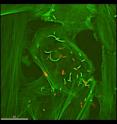Heart-targeting Listeria increase cardiac disease risk
Certain strains of the food pathogen Listeria are uniquely adapted to infect heart tissues and may put people at a higher risk from serious cardiac disease, according to a new study published in the Journal of Medical Microbiology. Developing new diagnostic tests to identify these potentially fatal strains could protect those most at risk, such as those with heart valve replacements. Researchers from the University of Illinois, Chicago have shown that a sub-population of the bacterium Listeria monocytogenes display an enhanced ability to infect cardiac tissue. They found that mice infected with certain strains of L. monocytogenes had 10-15-fold more bacteria in their heart tissues than mice infected with other strains.
L. monocytogenes is a serious food-borne pathogen which may be found in soft cheeses and chilled ready-to-eat products. Less severe infections lead to gastroenteritis. Serious infections are most commonly associated with the central nervous system or with the developing fetus in pregnant women. Dr Nancy Freitag who led the study explained how a subset of infections progress differently. "A significant number - about 10% - of L. monocytogenes infections involve the heart. In these cases death rate from cardiac illness is estimated to be up to 35% yet very little is known about how these bacteria infect heart tissues."
The results of the study suggest that these cardiac-associated strains display modified proteins on their surface that enable the bacteria to target the heart, leading to bacterial infection. "We found distinct genetic similarities between the cardioinvasive Listeria versus the other strains that we compared. These similarities all related to the surface proteins on the bacteria," said Dr Freitag.
The group are hoping to develop diagnostic tests based on bacterial genetic markers. "These tests could be used to distinguish strains of Listeria isolated from food outbreaks, food processing plants, or from clinical infections that place patients at increased risk of cardiac disease," suggested Dr Freitag. "This would allow health care workers and food safety officials to closely monitor exposed individuals."
The ability to identify cardiac-targeting strains of Listeria could improve infection outcomes and help protect vulnerable groups. "Patients with heart valve replacements or prior cardiac illness are believed to be more susceptible to Listeria cardiac infections. It is not clear exactly why this is so, but it could be that damaged tissue provides an additional entry way for infection," explained Dr Freitag. "We believe that this risk may be increased if the individuals are exposed to cardiac-targeting strains," she said.
Source: Society for General Microbiology
Articles on the same topic
- Food-borne bacteria causes potentially fatal heart infectionWed, 26 Jan 2011, 19:08:30 UTC
Other sources
- Food-borne bacteria causes potentially fatal heart infectionfrom Science DailyWed, 26 Jan 2011, 20:32:01 UTC
- Food-borne bacteria causes potentially fatal heart infectionfrom Science BlogWed, 26 Jan 2011, 20:30:21 UTC
- Food-Borne Bacteria Causes Potentially Fatal Heart Infectionfrom Newswise - ScinewsWed, 26 Jan 2011, 19:33:55 UTC
- Heart-targeting Listeria increase cardiac disease riskfrom PhysorgWed, 26 Jan 2011, 10:01:32 UTC
